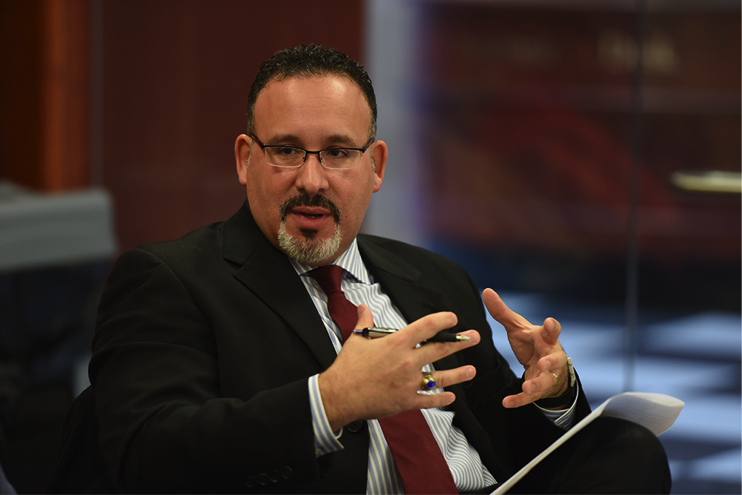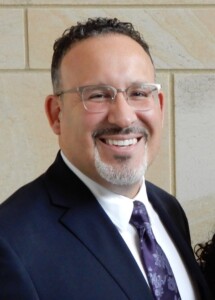
Editor’s note: Teach Connecticut posted the following article by Dr. Miguel Cardona on its website as part of its Hispanic Heritage Month campaign to honor inspiring educators. The Alma Exley Scholarship Program honored Dr. Cardona in 1998 when he was a student at Central Connecticut State University.
By Miguel Cardona, Ed.D.
Like many first generation Latinos whose parents came from another country, I had to learn how to code-switch early. At first it was with language, but it soon became necessary for other nuances of the cultures in which I was immersed.
Navigating the dominant cultural norms in dress, idiomatic expressions and music, among other things, I was always reminded to stay proud and celebrate my Puerto Rican roots.
So while my playlists growing up included popular American music, there was always Felipe Rodriguez, Los Condes, Eddie Santiago and, of course, Marc Anthony.
Despite being the only Latino in many of my college preparation high school classes and throughout my college courses, my ability to develop dual consciousness while staying true to who I am only helped me build confidence. It’s very difficult to explain that process — Lejuan James does it best!
I remember when I got the call from the superintendent asking me to teach fourth grade in my hometown of Meriden, CT, a diverse community that my parents came to call home as young children. What a life-changing experience to teach in your own community!
Living Your Life’s Purpose in the Profession
I remember thinking then that teaching is not a job. It is an extension of you as a person.
If you keep that mindset, you can live out your life’s purpose every day in the profession.
After several years of teaching, I was fortunate to receive a master’s fellowship in Bilingual Bicultural Education at the University of Connecticut. There I met some mentors and models in education who motivated me to continue my passion for learning and teaching in ways that students enjoy.
After graduating, I made the choice not to teach in Bilingual Education, simply because I felt non-Bilingual Education students also need to see Latinos in professional capacities.
Devoted To Evolving the Thinking of the Next Generation
Like many, I remember what it felt like to be on the wrong side of a stereotype, and I felt it was my purpose in education to evolve the thinking of the next generation. Equity became a foundation for my passion around this time.
Fast forward a bit, I get my administrative degree to become Connecticut’s youngest principal in 2003. The expectations kept mounting, but so did my passion for learning, growing and serving my purpose to teach and lead.
A Culture of Acceptance
Serving as a building principal allowed me to create a culture of acceptance, high achievement and community. Some of my fondest memories as an educator was when I was principal.
In 2012, I represented Connecticut in Washington, DC, as Connecticut’s National Distinguished Principal. It was around that time that I was finishing up my doctorate degree. I chose my dissertation topic, Sharpening the Focus of Political Will to Address Achievement Disparities, because that continued to be a passion of mine. Walking on the stage at the commencement ceremony and receiving my doctorate degree with a whole section of family and supporters in the stands was a moment I will never forget.
While the sacrifice of earning my degree seemed daunting, it was dwarfed by the sacrifice and commitment my grandparents and parents made: leaving a beautiful island to become strangers in a new land, living in the housing projects, and starting from the bottom. They earned my degree with me.
Soon after I graduated, I was asked by the Connecticut Speaker of the House of Representatives to serve as the Co-Chairperson of the Legislative Achievement Gap Task Force in the capital city of Hartford. I remember sitting with the Lieutenant Governor, Commissioner of Education and various State Senators and Representatives, chuckling to myself because those same skills of code and culture switching I did as a young kid were serving me well.
Negotiating public policy on behalf of thousands of Connecticut students who reminded me of my parents when they emigrated from Puerto Rico made my experience worthwhile. It was during this time that I felt my job as Principal and Task Force Co-Chair was truly serving my purpose in life. I realized the importance of carrying that purpose on my sleeve.
Three Things To Remember
After 10 years as Principal, I moved to Central Office and now serve as the Assistant Superintendent for Teaching and Learning in the Meriden Public School System, the same school system my parents and I went through, and the one that my children now attend.
Lead by example
I am fortunate to be in Meriden, my hometown, and my passion for serving this community is part of the reason I choose to stay. Latinos are very familial. This community has embraced me as family, and I am committed to making its continuous improvement my life’s work.
Teaching is an extension of your purpose. Be prepared to defend your beliefs, challenge conventions and be a part of the change you want to see.
As Assistant Superintendent and adjunct professor of educational leadership at University of Connecticut, I combine my two passions: leading a diverse district and teaching tomorrow’s leaders.
Remember the three things I learned on my journey:
- Everyone benefits from seeing Latinos in a professional position.
- You must find and wear your purpose on your sleeve.
- Most importantly, you must remember that teaching is not a job, but an extension of your life’s purpose. Be the change you wish to see.
Find Your Life’s Purpose
If you’re ready to become a teacher—or if you know someone who would be a great fit for the profession—let them know about TEACH Connecticut, and encourage them to create a free career roadmap. It’s the easiest way to determine your fit for teaching and get actionable next steps for starting your career.


